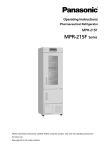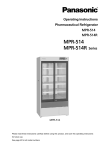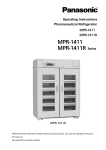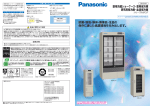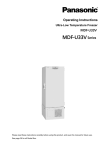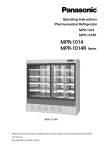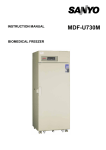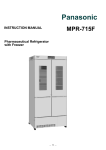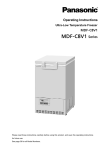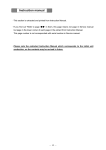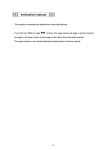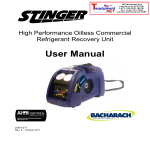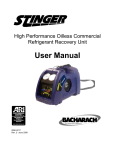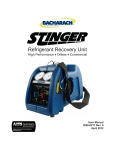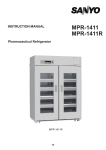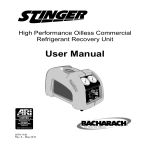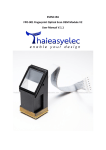Download - Panasonic Biomedical
Transcript
Operating Instructions Pharmaceutical Refrigerator MPR-414F MPR-414FS MPR-414F MPR-414FS Series MPR-414F Please read these instructions carefully before using this product, and save this operating instructions for future use. See page 33 for all model numbers. CONTENTS INTRODUCTION P. 3 PRECAUTIONS FOR SAFE OPERATION P. 4 ENVIRONMENTAL CONDITIONS P. 8 REFRIGERATOR COMPONENTS P. 9 Control panel P. 11 INSTALLATION SITE P. 12 INSTALLATION P. 13 START-UP OF UNIT P. 14 TEMPERATURE SETTING P. 15 KEY LOCK FUNCTION P. 16 DEFROSTING OF FREEZER P. 16 DEFROSTING P. 17 ALARM TEMPERATURE SETTING P. 18 SETTING OF ALARM RESUME TIME P. 20 REMOTE ALARM TERMINAL P. 20 ALARMS AND SAFETY FUNCTIONS P. 21 ROUTINE MAINTENANCE Cleaning P. 22 Replacement of lamp P. 23 TROUBLESHOOTING P. 24 DISPOSAL OF UNIT P. 24 OPTIONAL COMPONENT Temperature recorder P. 29 Installation of temperature recorder P. 30 SPECIFICATIONS P. 32 PERFORMANCE P. 33 SAFETY CHECK SHEET P. 34 2 INTRODUCTION Read this operating instructions carefully before using the appliance and follow the instructions for safety operation. Our company never guarantee any safety if the appliance is used for any objects other than intended use or used by any procedures other than those mentioned in this operating instructions. Keep this operating instructions in an adequate place to refer to it as necessary. The contents of the operating instructions will be subjected to change without notice due to the improvement of performance or functions. Contact our sales representative or agent if any page of the operating instructions is lost or page order is incorrect. Contact our sales representative or agent if any point in this operating instructions is unclear or if there are any inaccuracies. No part of this operating instructions may be reproduced in any form without the expressed written permission of our company. CAUTION Our company guarantees the product under certain warranty conditions. way shall be responsible for any loss of content or damage of content. 3 Our company in no PRECAUTIONS FOR SAFE OPERATION It is imperative that the user complies with this operating instructions as it contains important safety advice. Items and procedures are described so that you can use this unit correctly and safely. If the precautions advised are followed, this will prevent possible injury to the user and any other person. Precautions are illustrated in the following way: WARNING Failure to observe WARNING signs could result in a hazard to personnel possibly resulting in serious injury or death. CAUTION Failure to observe CAUTION signs could result in injury to personnel and damage to the unit and associated property. Symbol shows; this symbol means caution. this symbol means an action is prohibited. this symbol means an instruction must be followed. Be sure to keep this operating instructions in a place accessible to users of this unit. < Label on the unit > This mark is labeled on the cover in which the electrical components of high voltage are enclosed to prevent the electric shock. The cover should be removed by a qualified engineer or a service personnel only. 4 PRECAUTIONS FOR SAFE OPERATION WARNING Do not use the unit outdoors. Current leakage or electric shock may result if the unit is exposed to rain water. Only qualified engineers or service personnel should install the unit. The installation by unqualified personnel may cause electric shock or fire. Install the unit on a sturdy floor and take an adequate precaution to prevent the unit from turning over. If the floor is not strong enough or the installation site is not adequate, this may result in injury from the unit falling or tipping over. Never install the unit in a humid place or a place where it is likely to be splashed by water. Deterioration of the insulation may result which could cause current leakage or electric shock. Never install the unit in a flammable or volatile location. This may cause explosion or fire. Never install the unit where acid or corrosive gases are present as current leakage or electric shock may result due to corrosion. Always ground (earth) the unit to prevent electric shock. If the power supply outlet is not grounded, it will be necessary to install a ground by qualified engineers. Never ground the unit through a gas pipe, water main, telephone line or lightning rod. Such grounding may cause electric shock in the case of an incomplete circuit. Connect the unit to a power source as indicated on the rating label attached to the unit. Use of any other voltage or frequency other than that on the rating label may cause fire or electric shock. Never store volatile or flammable substances in this unit if the container cannot be sealed. These may cause explosion or fire. Do not insert metal objects such as a pin or a wire into any vent, gap or any outlet on the unit. This may cause electric shock or injury by accidental contact with moving parts. Use this unit in safe area when treating the poison, harmful or radiate articles. Improper use may cause bad effect on your health or environment. Turn off the power switch (if provided) and disconnect the power supply to the unit prior to any repair or maintenance of the unit in order to prevent electric shock or injury. Do not touch any electrical parts (such as power supply plug) or operate switches with a wet hand. This may cause electric shock. 5 PRECAUTIONS FOR SAFE OPERATION WARNING Ensure you do not inhale or consume medication or aerosols from around the unit at the time of maintenance. These may be harmful to your health. Never splash water directly onto the unit as this may cause electric shock or short circuit. Never put containers with liquid on the unit as this may cause electric shock or short circuit when the liquid is spilled. Never bind, process, or step on the power supply cord, or never damage or break the power supply plug. A broken supply cord or plug may cause fire or electric shock. Do not use the supply cord if its plug is loose. Such supply cord may cause fire or electric shock. Never disassemble, repair, or modify the unit yourself. Any such work carried out by an unauthorized person may result in fire, or electric shock or injury due to a malfunction. Disconnect the power supply plug if there is something wrong with the unit. Continued abnormal operation may cause electric shock or fire. When removing the plug from the power supply outlet, grip the power supply plug, not the cord. Pulling the cord may result in electric shock or fire by short circuit. Disconnect the power supply plug before moving the unit. cord. Take care not to damage the power A damaged cord may cause electric shock or fire. Disconnect the power plug when the unit is not used for long periods. Keeping the connection may cause electric shock, current leakage, or fire due to the deterioration of insulation. If the unit is to be stored unused in an unsupervised area for an extended period, ensure that children do not have access and that doors cannot be closed completely. The disposal of the unit should be accomplished by appropriate personnel. Remove doors to prevent accidents such as suffocation. Do not put the packing plastic bag within reach of children as suffocation may result. 6 PRECAUTIONS FOR SAFE OPERATION CAUTION Use a dedicated power source (a dedicated circuit with a breaker) as indicated on the rating label attached to the unit. A branched circuit may cause fire resulting from abnormal heating. Connect the power supply plug to the power source firmly after removing the dust on the plug. A dusty plug or improper insertion may cause a heat or ignition. Never store corrosive substances such as acid or alkali in this unit if the container cannot be sealed. These may cause corrosion of inner components or electric parts. Check the setting when starting up of operation after power failure or turning off of power switch. The stored items may be damaged due to the change of setting. Be careful not to tip over the unit during movement to prevent damage or injury. Prepare a safety check sheet when you request any repair or maintenance for the safety of service personnel. 7 ENVIRONMENTAL CONDITIONS This equipment is designed to be safe at least under the following conditions (based on the IEC 61010-1): Indoor use; Altitude up to 2000 m; o o Temperature 5 C to 40 C o Maximum relative humidity 80% for temperature up to 31 C decreasing linearly to 50% relative humidity o at 40 C; Mains supply voltage fluctuations up to ±10% of the nominal voltage; Transient overvoltages up to the levels of OVERVOLTAGE CATEGORY Ⅱ; Temporary OVERVOLTAGES occurring on the mains supply; Applicable pollution degree of the intended environment (POLLUTION DEGREE 2 in most cases); 8 REFRIGERATOR COMPONENTS 1 2 3 4 5 6 7 17 8 16 9 10 10 Refrigerator 11 15 14 Freezer 13 4 12 MPR-414F with drawers (optional component) 9 REFRIGERATOR COMPONENTS 1. Circulating fan: This is for cooling the refrigerator uniformly. Fan is installed inside the enclosure. Do not insert anything into the enclosure. The air exhaust vent is located at the upper of the fan. 2. Air intake vent: Ensure this vent is never blocked. temperature distribution in the refrigerator. Failure to do so will result in unstable 3. Control panel: The operation status is displayed on this panel. available through this panel. Refer to page 11 for the details. And the temperature setting is 4. Mounting space for a temperature recorder: Space for a temperature recorder is available separately. See page 29 for the mounting of the temperature recorder. 5. Lamp: This lamp lights up when the refrigerator door is open to illuminate the chamber. 6. Glass window: Water can sometimes condense on the glass in areas of high humidity. the condensation with a dry soft cloth. (MPR-414FS has no glass window.) 7. Magnetic door gasket: This prevents the cool air from escaping. Wipe off Always keep clean. 8. Movable center pillar: The pillar contact the door gasket firmly when the door is closed and functions as a block between the chamber and outer air. When the door is opened, the pillar angle is changed by 90 degree. Take care not to change the pillar angle. 9. Protective sheet: The stored material may be frozen if it is put on the chamber bottom directly. Always put the sheet in the refrigerator compartment (upper and lower left chamber). 10. Lock: Turn a key clockwise through 180 degree to lock the door. The right side lock is for the right upper and lower doors and left side lock is for the left upper and lower doors. 11. Access port (rear): 12. Leveling feet: This port allows cables to be passed into the cabinet. Use these bolts to adjust the height and level the unit for installation. 13. Remote alarm terminal: for the details. This is used to alarm the abnormality to the remote location. See page 20 14. Power switch (also functions as a circuit breaker): The power switch also used as a circuit breaker. Normally put a cover on the switch. The round button under the power switch is a leakage test button. The operation check of the circuit breaker can be performed by pressing this button. But note the power supply to the unit is disconnected when this button is pressed. 15. Drawer: Drawers are available as an optional component (MPR-41R). 16. Shelf (at the opening between upper and lower chamber): Ensure this surface is never blocked by the stored items so that the cool air can be circulated into the lower chamber. 17. Cool air exhaust vent: flow can be frozen. Ensure this vent is never blocked. 10 Note the items exposed to the direct air REFRIGERATOR COMPONENTS Control panel 1 2 3 4 5 REFRIGERATOR FREEZER DOOR REF. FREEZ. 10 9 1. Door check lamp (DOOR): 2. Alarm lamp (ALARM): 8 7 6 This lamp is lit when the door is open. This lamp is flashed during alarm condition. Refer to page 18 “Alarm temperature setting”. 3. Freezer indicator (FREEZER): This indicator is lit when the freezer is selected. 4. Refrigerator indicator (REFRIGERATOR): 5. Temperature display: This indicator is lit when the refrigerator is selected. This indicator shows the chamber temperature, set temperature, or error code. 6. Numerical value shift key ( change. ): Pressing this key in the setting mode causes the numerical value to “ON-OFF” of key lock can be selected by pressing this key in the key lock mode. 7. Digit shift key ( ): Pressing this key in set mode causes the changeable digits to move. is activated by pressing this key for more than 5 seconds in the temperature display mode. Key lock See “Key lock function” on page 16. 8. Set key (SET): flashed. Pressing this key activates temperature set mode and the digit which can be set is By pressing the key again after setting, the set value is accepted. 9. Display select key (REF./FREEZ.): By pressing this key, chamber temperature display of refrigerator or freezer and each setting is selected. 10. Alarm buzzer stop key (BUZZER): operates and buzzer sounds. Press this key to silence the buzzer in the event that the alarm See page 21 for the details. 11 INSTALLATION SITE To operate this unit properly and to obtain maximum performance, install the unit in a location with the following conditions: A location not subjected to direct sunlight Do not install the unit under direct sunlight. Installation in a location subjected to direct sunlight cannot obtain the intended performance. A location with adequate ventilation Leave at least 10 cm around the unit for ventilation. performance and consequently the failure. Poor ventilation will result in a reduction of the A location away from heat generating sources Avoid installing the unit near heat-emitting appliances such as a heater or a boiler etc. decrease the intended performance of the unit. A location with little temperature change Install the unit under stable ambient temperature. o +35 C. Heat can The allowable ambient temperature is between -5 and A location with a sturdy and level floor Always install the unit on a sturdy and level floor. The uneven floor or tilted installation may cause failure or injury. Install the unit in stable condition to avoid the vibration or noise. Unstable condition may cause vibration or noise. WARNING Install the unit on a sturdy floor. If the floor is not strong enough or the installation site is not adequate, this may result in injury from the unit falling or tipping over. Select a level and sturdy floor for installation. This precaution will prevent the unit from tipping. Improper installation may result in water spillage or injury from the unit tipping over. A location not prone to high humidity Install the unit in the ambient of 80% R.H. or less humidity. current leakage or electric shock. Installation under high humidity may cause WARNING Do not use the unit outdoors. Current leakage or electric shock may result if the unit is exposed to rain water. Never install the unit in a humid place or a place where it is likely to be splashed by water. Deterioration of the insulation may result which could cause current leakage or electric shock. CAUTION The unit starts defrosting frequently due to excessive frost on the evaporator if it is installed in high o temperature and high humidity location. The chamber temperature goes up to approximately 10 C temporarily during defrosting. A location without flammable or corrosive gas Never install the unit in a flammable or volatile location. This may cause explosion or fire or may result in the current leakage or electric shock by the corrosion of the electrical components. A location without the possibility of anything fall Avoid installing the unit in the location where anything can fall down onto the unit. breakdown or failure of the unit. 12 This may cause the INSTALLATION 1. Remove the packaging materials and tapes Remove all transportation packaging materials and tapes. Open the doors and ventilate the unit. If the outside panels are dirty, clean them with a diluted neutral dishwashing detergent. (Undiluted detergent can damage the plastic components. For the dilution, refer to the instruction of the detergent.) After the cleaning with the diluted detergent, always wipe it off with a wet cloth. Then wipe off the panels with a dry cloth. Note: Leveling feet Fig.1 Remove the cable tie banding the power supply cord. Prolonged banding may cause the corrosion of the cord coating. 2. Adjusting the leveling foot Extend the leveling feet by rotating them counterclockwise to contact them to the floor. Ensure the unit is level. (Fig.1) 3. Fixing the unit Fixture Two fixtures are attached to the rear of the frame. Fix the frame to the wall with these fixtures and rope or Fig.2 chain. (Fig.2) 4. Ground (earth) WARNING Use a power supply outlet with ground (earth) to prevent electric shock. If the power supply outlet is not grounded, it is necessary to install a ground by qualified engineers. Never ground the unit through a gas pipe, water main, telephone line or lightning rod. Such grounding may cause electric shock in the case of an incomplete circuit. Note: If an instrument requiring a power source is to be placed inside the cabinet, the cable can be lead through the access port on the back side of the cabinet. should be replaced to seal the access port. After using of the port, a rubber cap and insulation Failure to do this can affect the temperature uniformity inside the cabinet and lead to condensation on the outside of the access port. 13 START-UP OF UNIT The following procedures should be adhered to for initial start-up and continuous operation. 1. Connect the unit to dedicated power supply. Do not put any product in the unit at this time. Note: If the unit is unplugged or the power to the unit is interrupted, do not restart the unit for at least 5 minutes. This protects the compressor. 2. On start-up, the alarm buzzer sometimes operates. In this case, stop the buzzer by pressing the alarm buzzer stop key (BUZZER). 3. Set the desired temperature. 4. Confirm that the chamber temperature is at the desired temperature. 5. When you are satisfied that the unit is working correctly, begin slowly placing product into the chamber to minimize the temperature rise. Note: Fix the shelves securely. Place items on the shelves and leave a space between the walls of the cabinet and the contents to allow air circulation. Do not place items on the floor of the chamber. CAUTION This inner cabinet is refrigerated by the forced circulation of cooled air inside the chamber. the intake and exhaust vents are not blocked. inside the unit to allow air circulation. Ensure that Adequate space should be provided between the items o Too much stock will result in temperature of about -2 C around the o exhaust vent when the set temperature is 2 C. o o It is recommended to set the temperature to 4 C or 5 C when a large quantity of articles that should not be frozen are stored. The heat discharge pipe is attached inside of the rear frame. The rear frame is sometimes hot at the start-up of the operation. But this does not mean malfunction. 14 TEMPERATURE SETTING Table 1 shows the basic operation method. Perform key operation in the sequence indicated in the table. o The example in the table is based on the assumption that the refrigerator temperature is 4 C and the o freezer temperature is -25 C. o Note: The unit is set at the factory so that the refrigerator temperature is 5 C and the freezer o temperature is -20 C. Table 1 Operation Connect to the power source and turn 1 on the power switch. 2 o Select refrigerator (REF.)by pressing display select key. Key operated ----REF. FREEZ. 3 Press set key. 4 SET Set to 004 by using digit shift key and numerical value shift key. 5 Press set key. 6 Select freezer (FREEZ.) by pressing display select key. SET REF. FREEZ. 7 Press set key. 8 o Basic operation procedure (Example of setting: refrigerator; 4 C, freezer; -25 C) SET Set to -25 by using digit shift key and numerical value shift key. 9 Press set key. SET Indication after operation The current refrigerator or freezer temperature is displayed. The refrigerator indicator lights and the current refrigerator temperature is displayed. The current set temperature is displayed and the second digit of the temperature display flashes. Pressing the key leads the flash of the first digit. Pressing the key shifts up the figure of the current digit. The value is stored in memory and the current refrigerator temperature is displayed. The freezer indicator lights and the current freezer temperature is displayed. The current set temperature is displayed and the second digit of the temperature display flashes. Pressing the key leads the flash of the first digit. Pressing the key shifts up the figure of the current digit. The value is stored in memory and the current freezer temperature is displayed. Note: If no key has been pressed for about 90 seconds in the temperature set mode, the display mode returns automatically to the temperature display mode. In this case, the chamber temperature setting is not changed. o The effective temperature setting for refrigerator ranges between 2 and 14 C. The stored items can be frozen partially when the set temperature of refrigerator is equal to or lower than o 3 C. o The freezer temperature can be set in the range between -15 and -35 C. o o temperature with no load at an ambient temperature of 30 C is -30 C. 15 Remember that the guaranteed KEY LOCK FUNCTION This unit incorporates a key lock feature which can inhibit the tampering using the keys on the control panel. The key lock is set to OFF at the factory. Display L0 L1 Table 2 Mode Key lock OFF Key lock ON Key lock setup procedure (Example: Operation Function Temperature change enabled Temperature change disabled Key lock OFF ⇒ Key lock ON) Key operated Press and hold the digit shift key for about 5 seconds. Set the first digit to 1 with 2 the numerical value shift key. 1 3 Press the set key. SET Indication after operation The current refrigerator or freezer temperature is displayed. The first digit of the temperature display blinks. Pressing the key shifts up the figure of the digit. Key lock is set to ON and the current refrigerator or freezer temperature is displayed. Note: Key lock can be set any time when the current refrigerator or freezer temperature is displayed. DEFROSTING OF FREEZER Table 3 below shows the procedure for defrosting of freezer or stopping the freezer operation. Table 3 Operation Select freezer (FREEZ.)by pressing 1 display select key. 2 Press the set key. 3 Key operated Indication after operation REF. The current freezer temperature FREEZ. is displayed. SET Set to -00 by using digit shift key and numerical value shift key. 4 Press the set key. SET 5 Check the defrosting is finished. Set the freezer temperature by the 6 procedure 6 through 9 in Table 1 and start the freezer operation. 16 The current set value is displayed and the second digit of the temperature display flashes. Pressing the key leads blink of the first digit of the temperature display. Pressing the key shifts up the figure of the current digit. The value is stored in memory and the current freezer temperature and dF is displayed alfternately. (starting of defrosting) DEFROSTING Refrigerator The following 2 kinds of defrost methods are adopted for the refrigerator, which control defrosting automatically. ■Cycle defrost To keep the temperature stable inside the chamber, the refrigeration compressor is cycled on and off. During “off” periods any frost which has accumulated on the evaporator is melted by energizing a heater. This will not have any discernible effect on the chamber temperature. ■Forced defrost When the ambient humidity is high, or a large amount of damp product is being stored inside the refrigerator, there is a possibility that cycle defrost may not be enough to remove all of the frost on the evaporator. In this case, a forced defrost cycle is initiated by the defrost sensor. When the unit is operating under a forced defrost cycle, the current chamber temperature and “dF” is displayed alternately on the digital temperature display. Once the forced defrost cycle is complete, normal operation resumes. The chamber air temperature o rises up to about 10 C during the forced defrost cycle. CAUTION The unit may collect excessive frost on the evaporator if it is installed in high temperature and high o humidity location. For example, the unit starts to defrost once a week with 2 C setting in the ambient of o o 35 C and 80% R.H. The chamber temperature goes up to approximately 10 C temporarily during defrosting. Freezer Natural defrost by stopping operation. The defrosting is performed by stopping the freezer operation. When the frost is built-up on the freezer wall, defrost the freezer by the following procedure as the freezer has no automatic defrosting function. 1. Temporarily move all the contents of the freezer to another freezer. 2. Set the freezer temperature to -00. on the digital temperature display. The current chamber temperature and “dF” is displayed alternately This is the starting of defrosting. 3. When the frost on the wall has been eliminated, remove the water and wipe the inside of the freezer completely. 4. Set the freezer temperature to desired one. 5. Once the chamber temperature has reached to the desired temperature, place the original contents back in the freezer. Note: The freezer does not automatically reset to normal operation. No temperature alarm is occurred during defrosting. CAUTION The cooling pipe is routed in the rear of the freezer. the frost. Never use a knife or a screw driver, etc. to remove They may cause damage of chamber wall or improper operation of the unit. any heavy items or sharp edge materials onto the freezer floor. Under such condition, the freezer is not cooled down at all. 17 And do not drop ALARM TEMPERATURE SETTING The high temperature and low temperature at which the alarm will be activated are effective for freezer and refrigerator. Display F01 F02 F03 F04 The following shows the outline of the alarm temperature setting. Mode High temp. alarm setting Low temp. alarm setting High temp. alarm setting Low temp. alarm setting Application Settable range o +2 to +14 C o -2 to -14 C o +5 to +15 C o -5 to -15 C Refrigerator Freezer Table 4 shows the basic operation for high temperature alarm setting and table 5 shows low temperature alarm setting for refrigerator. Perform key operation in the sequence indicated in the table. The example in the table is based on the assumption that the high temperature alarm is activated when the o chamber temperature deviates from set temperature by more than +3 C and low temperature alarm is o activated when the chamber temperature deviates from set temperature by more than -3 C. Note: The temperature alarm setting at the factory is as follows: High temp. alarm Refrigerator Freezer Low temp. alarm o o Set temp. +5 C Set temp. -5 C o o Set temp. +10 C Set temp. -10 C Table 4 Operation Key operated ----- 1 Press and hold the numerical value shift key for about 5 seconds. Set the first digit to 1 with the 3 numerical value shift key. (Note 1) 2 4 Press the set key. 5 SET Set to 003 by using digit shift key and numerical value shift key. 6 Press the set key. SET Note 1: For the freezer, set the first digit to 3 (F03). 18 Indication after operation The current refrigerator temperature is displayed. The first digit of the temperature display blinks. The first digit of the temperature display blinks. The current set value is displayed and the first digit of the temperature display flashes. Pressing the key leads the change of flashed digit. Pressing the key shifts up the figure of the current digit. The value is stored in memory and the current refrigerator temperature is displayed. ALARM TEMPERATURE SETTING Table 5 Operation Key operated ----- 1 Press and hold the numerical value shift key for about 5 seconds. Set the first digit to 2 with the 3 numerical value shift key. (Note 2) 2 4 Press the set key. 5 SET Set to -03 by using digit shift key and numerical value shift key. 6 Press the set key. SET Indication after operation The current refrigerator temperature is displayed. The first digit of the temperature display blinks. The first digit of the temperature display blinks. The current set value is displayed and the first digit of the temperature display flashes. Pressing the key leads the change of flashed digit. Pressing the key shifts up the figure of the current digit. The value is stored in memory and the current refrigerator temperature is displayed. Note 2: For the freezer, set the first digit to 4 (F04). Note: • If the ambient temperature is fairly high, the alarm lamp is flashed, temperature display is flashed, and the buzzer sounds at the time of initial start up. temperature is decreased. • Always close the door firmly. The alarm is canceled automatically when the chamber The door check lamp is lit when the door is open. sounds two minutes after door opening. The alarm buzzer The buzzer can be canceled automatically when the door is closed. 19 SETTING OF ALARM RESUME TIME The alarm buzzer and remote alarm are silenced by pressing he alarm buzzer stop key (BUZZER) on the control panel during alarm condition. The buzzer and remote alarm will be activated again after certain suspension if the alarm condition is continued. The suspension time can be set by following the procedure shown in the Table 6 below. The example in the table is based on the assumption that the desired duration is 20 minutes. Note: The duration is set in 30 minutes at the factory. Table 6 Procedure for setting of alarm resume time (Example; change from 30 minutes to 20 minutes) Operation ----- 1 2 Press and hold the numerical value shift key for about 5 seconds. 3 Set to F25 by using digit shift key and numerical value shift key. 4 Press the set key. 5 Key operated SET Set to 020 by using numerical value shift key. 6 Press the set key. SET Indication after operation The current chamber temperature is displayed. The first digit of the temperature display blinks. Pressing the key leads the change of flashed digit. Pressing the key shifts up the figure of the current digit. The current set value is displayed and the second digit of the temperature display flashes. Pressing the key shifts up the figure in the second digit. The value is stored in memory and the current chamber temperature is displayed. • The settable alarm resume times are 10, 20, 30, 40, 50, or 60 minutes (The set values are 010, 020, 030, 040, 050, or 060). The buzzer would not reset if the resume time is set in 000. • The set mode returns to the temperature display mode automatically when 90 seconds has passed without any key operation. In this case, any setting before pressing set key (SET) is not memorized. REMOTE ALARM TERMINAL The terminal of the remote alarm is installed at the lower left side of the unit. The alarm is outputted from this terminal. Contact capacity is DC 30 V, 2 A. Contact output: At normal condition “Open” At abnormal condition “Close” Note: The alarm is actuated when the power supply cord is disconnected from the outlet since the condition is regarded as power failure. 20 Terminal ALARMS AND SAFETY FUNCTIONS This unit has the alarm and safety functions shown in Table 7, and also a self diagnostic function. Table 7 Alarms and safety functions Kind of alarm Situation or safety High temperature alarm Over-heat protector Low temperature alarm Over-cool protector Power failure alarm Door alarm Auto return Key lock • Refrigerator If the chamber temperature exceeds the set temperature. • Freezer If the chamber temperature exceeds the set temperature. • Refrigerator If the chamber temperature o exceeds 28 C. • Refrigerator If the chamber temperature is lower than the set o temperature or drops to 0 C or lower. • Freezer If the chamber temperature is lower than the set temperature. • Refrigerator If the chamber temperature o is equal or lower than 0 C. In the event of a power failure or disconnection of power supply plug from the outlet When the door is open. If a key operation is not performed for about 90 seconds in each setting mode. When the key lock is ON (L1). If the thermal sensor of refrigerator goes open (E01) or short circuit (E02). If the freezer sensor of Thermal sensor freezer goes open (E03) abnormality or short circuit (E04). If the defrost sensor goes open (E05) or short circuit (E06). Indication Alarm lamp flashes. All digits on the temperature display flash. ----- Alarm lamp flashes. All digits on the temperature display flash. Buzzer Intermittent tone after a delay of 15 minutes. ----- Intermittent tone after a delay of 15 minutes. (No delay in the o case of 0 C or lower) Safety operation Remote alarm is activated after a delay of 15 minutes. Defrost heater and fan motor for circulation turn OFF. Remote alarm is activated after a delay of 15 minutes. (No delay in the o case of 0 C or lower) ----- ----- Refrigerator comp. turns OFF. o Reset at about 6 C. ----- ----- Remote alarm is activated. Door check lamp is lit. Chamber temperature is displayed. ----Alarm lamp flashes. E01/02 and chamber temp. are displayed alternately on the temperature display. Alarm lamp flashes. E03/04 and chamber temp. are displayed alternately on the temperature display. Alarm lamp flashes. E05/06 and chamber temp. are displayed alternately on the temperature display. Intermittent tone after a delay of 2 minutes. ----- ----- Setting mode is canceled. ----- Key input is unable. Intermittent tone Remote alarm is activated. Operation by the defrost sensor. Remote alarm is activated. Freezer will run continuously . Remote alarm is activated. Normal running. Note: The alarm can be canceled by pressing the alarm buzzer stop key (BUZZER), but the remote alarm cannot be silenced. When more than two alarm conditions occur simultaneously, the smaller number error code has priority on the error display. After a power failure, the unit will resume operation with the set value that was in place before power failure occurred. 21 ROUTINE MAINTENANCE WARNING Always disconnect the power supply to the unit prior to any repair or maintenance of the unit in order to prevent electric shock or injury. Ensure you do not inhale or consume medication or aerosols from around the unit at the time of maintenance. These may be harmful to your health. Cleaning • Clean the unit once a month. Regular cleaning keeps the unit looking new. • Use a dry cloth to wipe off small amounts of dirt on the outside and inside of the unit and all accessories. If some of them are dirty, use a cloth containing diluted neutral dishwashing detergent (Undiluted detergent may break the plastic parts. For the dilution, follow the instruction enclosed with the detergent). When a diluted neutral dishwashing detergent is used, wipe the cabinet or accessories thoroughly with a cloth soaked in clean water. Then wipe the cabinet or accessories unit with a dry cloth to eliminate the moisture. • Never pour water onto or into the unit. Doing so can damage the electrical insulation and may cause electric shock or short circuit. • The compressor and other mechanical part are completely sealed. This unit requires absolutely no lubrication. • If condensation forms on the front glass or frame surface, wipe it off with a dry soft cloth. CAUTION Do not clean the unit with scrubbing brushes, acid, thinner, solvents powdered soap, cleanser or hot water. These agents can scratch the paint or cause it to peel. by these materials. Plastic and rubber parts can be easily damaged Especially never use any volatile solvent to clean the plastic or rubber parts. 22 ROUTINE MAINTENANCE Replacement of lamp Follow the procedure replacement of the lamp. below at the time of The lamp is located at the upper front side of refrigerator chamber. 1. Disconnect the power supply plug. 2. To remove the lamp cover, hold the both sides of the cover with flexure and push it backward. 3. Remove the bulb from the socket by turning it to Lamp (inside) Fig. 1 counterclockwise Caution: Take care not to injure the fingers as the bulb can be hot! Lamp cover < Bulb for replacement > Incandescent lamp (T22E17) 125 V, 10 W (for AC 110/115 V) Fig. 2 (T22E17) 250 V, 15 W (for AC 220/230/240 V) 4. Mount a new bulb and replace the lamp cover. Bulb Fig. 3 23 TROUBLESHOOTING If the unit malfunctions, check out the following before calling for service. In the case of no refrigeration or poor refrigeration, transfer the stored items to another refrigerator or freezer before checking out. Malfunction If nothing operates even when switched on When the unit does not Check/Remedy The unit is not connected to the power supply or capacity of power source is not enough. There is a power failure, the fuse is blown, or the circuit breaker is activated. The key lock function is set in ON mode. accept changes of set-point temperature When alarm is activated On start-up The temperature in the unit does not match set value. In use The door was kept opened for long time. The set value was changed. The containers of high temperature (load) were put in the unit. In these cases, alarm is removed automatically by running the unit for When unit does not get cold enough several hours. The air exhaust vent is blocked by refrigerator contents. A large amount of warm product was put in the unit. There is any heat sources in the unit. The door is opened frequently. The ambient temperature is too high. The unit is in direct sunlight. The door is not securely closed. The door seal is damaged or foreign substance inserted between the door gaskets. Note: If the malfunction is not eliminated after checking the above items, or the malfunction is not shown in the above table, contact our sales representative or agent. DISPOSAL OF UNIT WARNING If the unit is to be stored unused in an unsupervised area for an extended period ensure that children do not have access and doors cannot be closed completely. The disposal of the unit should be accomplished by appropriate personnel. doors to prevent accidents such as suffocation. 24 Always remove DISPOSAL OF UNIT Note: This symbol mark and recycle system are applied only to EU countries and not applied to the countries in the other area of the world. Waste Electrical and Electronic Equipment (WEEE) Directive-2002/96/EC (English) Your Panasonic product is designed and manufactured with high quality materials and components which can be recycled and reused. This symbol means that electrical and electronic equipment, at their end-of-life, should be disposed of separately from your household waste. Please dispose of this equipment at your local community waste collection/recycling centre. In the European Union there are separate collection systems for used electrical and electronic products. Please help us to conserve the environment we live in! (German) Ihr Panasonic Produkt wurde entworfen und hergestellt mit qualitativ hochwertigen Materialien und Komponenten, die recycelt und wiederverwendet werden können. Dieses Symbol bedeutet, daß elektrische und elektronische Geräte am Ende ihrer Nutzungsdauer von Hausmüll getrennt entsorgt werden sollen. Bitte entsorgen Sie dieses Gerät bei Ihrer örtlichen kommunalen Sammelstelle oder im Recycling Centre. In der Europäischen Union gibt es unterschiedliche Sammelsysteme für Elektrik- und Elektronikgeräte. Helfen Sie uns bitte, die Umwelt zu erhalten, in der wir leben! 25 DISPOSAL OF UNIT (French) Votre produit Panasonic est conçu et fabriqué avec des matèriels et des composants de qualité supérieure qui peuvent être recyclés et réutilisés. Ce symbole signifie que les équipements électriques et électroniques en fin de vie doivent être éliminés séparément des ordures ménagères. Nous vous prions donc de confier cet équipement à votre centre local de collecte/recyclage. Dans l’Union Européenne, il existe des systèmes sélectifs de collecte pour les produits électriques et électroniques usagés. Aidez-nous à conserver l’environnement dans lequel nous vivons ! Les machines ou appareils électriques et électroniques contiennent fréquemment des matières qui, si elles sont traitées ou éliminées de manière inappropriée, peuvent s’avérer potentiellement dangereuses pour la santé humaine et pour l’environnement. Cependant, ces matières sont nécessaires au bon fonctionnement de votre appareil ou de votre machine. Pour cette raison, il vous est demandé de ne pas vous débarrasser de votre appareil ou machine usagé avec vos ordures ménagères. (Spanish) Los productos Panasonic están diseñados y fabricados con materiales y componentes de alta calidad, que pueden ser reciclados y reutilizados. Este símbolo significa que el equipo eléctrico y electrónico, al final de su ciclo de vida, no se debe desechar con el resto de residuos domésticos. Por favor, deposite su viejo “televisor” en el punto de recogida de residuos o contacte con su administración local. En la Unión Europea existen sistemas de recogida específicos para residuos de aparatos eléctricos y electrónicos. Por favor, ayúdenos a conservar el medio ambiente! 26 DISPOSAL OF UNIT (Portuguese) O seu produto Panasonic foi concebido e produzido com materiais e componentes de alta qualidade que podem ser reciclados e reutilizados. Este símbolo significa que o equipamento eléctrico e electrónico no final da sua vida útil deverá ser descartado separadamente do seu lixo doméstico. Por favor, entregue este equipamento no seu ponto local de recolha/reciclagem. Na União Europeia existem sistemas de recolha separados para produtos eléctricos e electrónicos usados. Por favor, ajude-nos a conservar o ambiente em que vivemos! (Italian) Il vostro prodotto Panasonic è stato costruito da materiali e componenti di alta qualità, che sono riutilizzabili o riciclabili. Prodotti elettrici ed elettronici portando questo simbolo alla fine dell’uso devono essere smaltiti separatamente dai rifiuti casalinghi. Vi preghiamo di smaltire questo apparecchio al deposito comunale. Nell’Unione Europea esistono sistemi di raccolta differenziata per prodotti elettrici ed elettronici. Aiutateci a conservare l’ambiente in cui viviamo! 27 DISPOSAL OF UNIT (Dutch) Panasonic producten zijn ontwikkeld en gefabriceerd uit eerste kwaliteit materialen, de onderdelen kunnen worden gerecycled en weer worden gebruikt. Het symbool betekent dat de elektrische en elektronische onderdelen wanneer deze vernietigd gaan worden , dit separaat gebeurt van het normale huisafval. Zorg ervoor dat het verwijderen van de apparatuur bij de lokaal erkende instanties gaat gebeuren. In de Europese Unie wordt de gebruikte elektrische en elektronische apparatuur bij de daarvoor wettelijke instanties aangeboden. Alstublieft help allen mee om het milieu te beschermen. (Swedish) Din Panasonic produkt är designad och tillverkad av material och komponenter med hög kvalitet som kan återvinnas och återanvändas. Denna symbol betyder att elektriska och elektroniska produkter, efter slutanvändande, skall sorteras och lämnas separat från Ditt hushållsavfall. Vänligen, lämna denna produkt hos Din lokala mottagningstation för avfall/återvinningsstation. Inom den Europeiska Unionen finns det separata återvinningssystem för begagnade elektriska och elektroniska produkter. Vänligen, hjälp oss att bevara miljön vi lever i! 28 OPTIONAL COMPONENT Temperature recorder To record the chamber temperature, an optional temperature recorder is available. Please consult with our sales representative or agent for the installation of temperature recorder. For the proper usage of temperature recorder, refer to an instruction manual included with the temperature recorder. The available temperature recorder and its attachment location are as follows: Temp. recorder MTR-0621LH MTR-4015LH MTR-G3504A or MTR-G3504C Application For refrigerator For freezer For both refrigerator and freezer Location (see figure below) Front right of top panel, or Lower right of front panel (In the case of no use of MTR4015LH) Lower right of front panel Lower right of front panel Recorder fixing Fixing enclosed with the recorder MPR-S30 MPR-S30 MPR-S7 Temp. recorder for refrigerator (MTR-0621LH) Capillary tube Access port Recorder sensor Access port Capillary tube Recorder sensor Temp. recorder for freezer(MTR-4015LH) Recorder fixing(MPR-S30) Or Temp. recorder for both refrigerator & freezer (MTR-G3504A or MTR-G3504C) Recorder fixing(MPR-S7) WARING Always disconnect the power supply to the unit before starting the installation of temperature recorder to prevent electric shock or injury. 29 OPTIONAL COMPONENT Installation of temperature recorder Refrigerator (MTR-0621LH) 1. Attach the recorder fixing to the temperature recorder with two screws. (Fig. 1) 2. Remove the screws at the right corner on the top of the unit and fix the temperature recorder to the attachment position. (Fig. 2) 3. Remove a rubber cap and insulation covering the Fig. 1 access port on the back of the unit. 4. Take the recorder sensor into the refrigerator Fig. 2 chamber through the access port. 5. Fix the recorder sensor on the right wall of the chamber with the enclosed clips. (Fig. 3) 6. Arrange the capillary tube so that it cannot disturb the shelves. Take care not to crush the tube when it is bent. 7. Make a cut on the rubber cap and pass the capillary tube through it. (Fig. 4) 8. Cover the access port with the insulation and Fig. 3 rubber cap. Fig. 4 Note: The temperature recorder MTR-0621LH can be installed also at the mounting space of temperature recorder (bottom right of the cabinet) if the temperature recorder for freezer (MTR-4015LH) is not installed. In this case, a dedicated recorder fixing (MPR-S30) is needed. For the installation, refer to “For freezer (MTR-4015LH)” below. 30 OPTIONAL COMPONENT Cover panel For freezer (MTR-4015LH) 1. Remove a cap for the fixing screw on the panel cover for mounting space of temperature recorder. Shaft 2. Remove the fixing screw and open the panel cover. (Fig. 5) 3. Remove the panel cover by pushing the shaft on Fixing screw Fig. 5 both side outward. 4. Attach the temperature recorder (MTR-4015LH) to the recorder fixing (MPR-S30: optional component) by using the enclosed screws. (Fig. 6) 5. Mount the recorder fixing with recorder to the mounting space in the unit. (Fig. 7) 6. Route the recorder sensor and capillary tube as shown in the procedure 3 through 8 above and fix Fig. 6 Fig.7 the sensor on the freezer wall (Fig. 8). Note: The temperature recorder MTR-4015LH cannot be installed at the right corner on the top of the cabinet even if the temperature recorder for refrigerator (MTR-0621LH) is not installed there. Fig.8 For both refrigerator and freezer (MTR-G3504A or MTR-G3504C) Cover panel 1. Remove a cap for the fixing screw on the panel Shaft cover for mounting space of temperature recorder. 2. Remove the fixing screw and open the panel cover. (Fig. 9) Fixing screw Fig.9 3. Remove the panel cover by pushing the shaft on both side outward. 4. Attach the temperature recorder (MTR-G3504A or MTR-G3504C) to the recorder fixing (MPR-S7: optional component) by following the instruction shown in the procedure enclosed with the fixture. 5. Remove the connector cover. Fig.10 Then connect the power connector on the temperature recorder to the connector on the unit side. (Fig. 10) 6. Mount the recorder fixing with recorder to the Sensor for freezer Sensor for refrigerator mounting space in the unit. 7. Fix the recorder sensor to each chamber by using clips, as mentioned in the procedure for MTR-0621LH and MTR-4015LH above. Fig.11 31 SPECIFICATIONS Product name Pharmaceutical refrigerator MPR-414F MPR-414FS External dimensions W800 mm x D600 mm x H1805 mm Internal dimensions W720 mm x D495 mm x H1425 mm (Refrigerator) W317 mm x D440 mm x H576 mm (Freezer) 340 L (Refrigerator), 82 L (Freezer) Effective capacity Exterior Painted steel Interior Stainless steel (Refrigerator), Painted aluminum plate (Freezer) Door Painted steel Provided with glass window on the upper door (MPR-414F only) Rigid polyurethane foamed-in place Insulation Shelf Polyethylene coated wire 2 large size; W700 mm x D366 mm Max. load; 25 kg/shelf 3 small size; W317 mm x D366 mm Max. load; 15 kg/shelf 1 shelf; W297 mm x D366 mm Max. load; 15 kg/shelf <Refrigerator> <Freezer> Access port Cooling method Inner diameter 30 mm, 2 ports on the back side (refrigerator, freezer) Forced air circulation (Refrigerator), Direct cooling (Freezer) Compressor Hermetic reciprocating type, Output; 160 W x 2 Evaporator Fin and tube type (Refrigerator), Tube on sheet type (Freezer) Condenser Wire and tube (Refrigerator), Rear side condenser (Freezer) Refrigerant R-134a (Refrigerator), R-407D (Freezer) Defrosting Cycle defrost and forced defrost (Refrigerator) Natural defrost by stopping operation (Freezer) 99 W (Refrigerator) Defrost heater Temperature controller Microprocessor control system Temperature display Digital display Thermal sensor Thermister sensor (Refrigerator, Freezer) Alarm & Safety High temp. alarm, Low temp. alarm, Power failure alarm, Door alarm Over-heat protector (Refrigerator), Over-cool protector (Refrigerator) Key lock, Thermal sensor abnormality, Circuit breaker (acts as power switch as well) Nonvolatile memory Memory backup Lamp Weight Accessories Optional component Incandescent lamp (T22E17) x 1, 10W/15W (Refrigerator) 126 kg 119 kg 1 set of key, 2 large & 2 small nylon clips (for temperature recorder) Temperature recorder (MTR-G3504A or MTR-G3504C), Recorder fixing (MPR-S7) Temperature recorder for freezer (MTR-4015LH), Recorder fixing (MPR-S30) Temperature recorder for refrigerator (MTR-0621LH) Drawers rack for the bottom left compartment (MPR-41R) ・Design or specifications will be subject to change without notice. ・Refer to the updated catalog when ordering an optional component. 32 PERFORMANCE Product name Model number Control range Noise level Pharmaceutical Refrigerator MPR-414F MPR-414F-PB MPR-414F-PK MPR-414F-PA MPR-414F-PE MPR-414F-PT o o o o Refrigerator: 2 C to 14 C (Ambient temp.; -5 C to +35 C, No load) o o o o Freezer: -20 C to -30 C (Ambient temp.; -5 C to +30 C, No load) 39 dB (A scale) Maximum pressure Rated voltage Rated frequency Power consumption 1.46 MPa (Refrigerator), 2.18 MPa (Freezer) AC 110 V/115 V AC 220 V AC 220 V AC 230 V/240 V 60 Hz 50 Hz 60 Hz 50 Hz 375 W/390 W 350 W 370 W 350 W/365 W Note :The unit with CE mark complies with EC directives. Product name Model number Control range Noise level Pharmaceutical Refrigerator MPR-414FS MPR-414FS-PB MPR-414FS-PK MPR-414FS-PA MPR-414FS-PE MPR-414FS-PT o o o o Refrigerator: 2 C to 14 C (Ambient temp.; -5 C to +35 C, No load) o o o o Freezer: -20 C to -30 C (Ambient temp.; -5 C to +30 C, No load) 39 dB (A scale) Maximum pressure Rated voltage Rated frequency Power consumption 1.46 MPa (Refrigerator), 2.18 MPa (Freezer) AC 110 V/115 V AC 220 V AC 220 V AC 230 V/240 V 60 Hz 50 Hz 60 Hz 50 Hz 375 W/390 W 350 W 370 W 350 W/365 W Note :The unit with CE mark complies with EC directives. 33 CAUTION Please fill in this form before servicing. Hand over this form to the service engineer to keep for his and your safety. Safety check sheet 1. Refrigerator contents : Risk of infection: Risk of toxicity: Risk from radioactive sources: □Yes □Yes □Yes □Yes □No □No □No □No (List all potentially hazardous materials that have been stored in this unit.) Notes : 2. Contamination of the unit: Unit interior: No contamination: Decontaminated: Contaminated: Others: □Yes □Yes □Yes □Yes □No □No □No □No 3. Instructions for safe repair/maintenance of the unit a) The unit is safe to work on □Yes □No b) There is some danger (see below) □Yes □No Procedure to be adhered to in order to reduce safety risk indicated in b) below. Date : Signature : Address, Division : Telephone : Product name: Pharmaceutical Model: Serial number: Date of installation: MPR- Refrigerator Please decontaminate the unit yourself before calling the service engineer. 34 1-1-1 Sakata, Oizumi-Machi, Ora-Gun, Gunma 370-0596, Japan © Panasonic Healthcare Co., Ltd. 2012 Printed in Japan 7FB6P151335001 S0412-10712



































